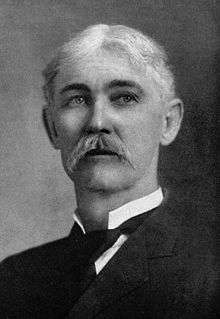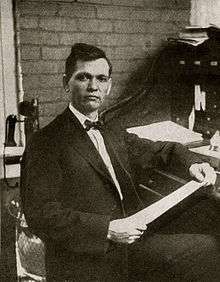Appeal to Reason (newspaper)

The Appeal to Reason was a weekly left-wing political newspaper published in the American Midwest from 1895 until 1922. The paper was known for its politics, lending support over the years to the Farmers' Alliance and People's Party before becoming a mainstay of the Socialist Party of America, following that organization's establishment in 1901. Making use of a network of highly motivated volunteers known as the "Appeal Army" to spur subscription sales, paid circulation of the Appeal climbed to more than a quarter million copies by 1906 and half a million by 1910, making it the largest-circulation socialist newspaper in American history.
Publication history
The most direct ancestor of the Appeal was the The Coming Nation, a socialist communalist paper established by Julius Augustus Wayland in Greensburg, Indiana. It was moved to the utopian socialist Ruskin Colony in Tennessee as part of an effort to form a socialist colony there. When Wayland tired of the colony, he left his newspaper behind with the colonists, moving to Kansas City, Kansas, to publish his own independently weekly, Appeal to Reason, established on August 31, 1895.[1]
Publication of the newspaper was briefly suspended in October 1896 when Wayland left Kansas City for the small town of Girard, Kansas, located in the southeastern corner of the state. Girard was the center of coal mining in Kansas and included many radical miners who had recently immigrated from Europe.[2] Although originally just a one-week hiatus was planned,[3] publication was actually suspended for more than three months.[4]
Following the collapse of the Ruskin Colony, a second Coming Nation was published by Wayland at Girard but folded two years later. The run of the first two incarnations, which followed a continuous whole number scheme, was #1 April 29, 1893 to #512 December 26, 1903.[5]
Growth

By 1910, the newspaper employed approximately 60 workers and boasted a "three-deck, straight-line Goss machine that prints four hundred twelve-page papers, in colors, folded, per minute, when desired."[2] The Appeal was based out of a building with the dimensions "...eighty by one hundred feet, two stories and basement."[2] In 1910, it had a weekly circulation of 550,000 and a subscription base of 450,000.[6]
The paper's popularity was powered by a folksy style of writing and the participation of many leading literary luminaries of the Socialist movement, including Upton Sinclair,[7] Jack London, Mary "Mother" Jones, Eugene Debs, and Helen Keller.
Decline
After founder Wayland died by suicide in 1912, the Appeal slowly lost its vitality. Wayland's sons were not temperamentally suited to the newspaper business. After a series of editorials attacking American militarism and conscription policies during the First World War, the federal government rescinded the paper’s second-class mailing rights. This, combined with the post–Russian Revolution “Red Scare” and the restrictions of the Espionage Act (as well as infighting among American socialists), led to a drastic reduction in subscriptions. The paper was sold to Marcet and Emanuel Haldeman-Julius, the latter an editor of the paper. The paper alienated a good part of its anti-militarist socialist readership by endorsing the American war effort. From issue #1151, dated December 22, 1917, to issue #1212 of February 22, 1919, the paper carried the title New Appeal to denote its new patriotic orientation. Building on the subscriber list of the Appeal, from 1919 on, Haldeman-Julius developed a very successful business selling inexpensive paperback booklets known as the Little Blue Books.
Successors and demise
The Appeal to Reason name was terminated in November 1922, to be replaced by the Haldeman-Julius Weekly.[8] This new incarnation rapidly lost its socialist character and became a "house organ" for Haldeman-Julius's lucrative publishing business.
This publication saw its name changed again to The American Freeman, effective with issue #1741 of April 13, 1929.[9] This publication continued until Haldeman-Julius' death in November 1951.
Legacy
Upton Sinclair's novel The Jungle was first published as a serial in the Appeal to Reason,[7] between February 25, 1905 and November 4, 1905.[10]
Circulation
| Year | Circulation | Notes and references |
|---|---|---|
| 1895 | ||
| 1896 | ||
| 1897 | ||
| 1898 | ||
| 1899 | ||
| 1900 | ||
| 1901 | ||
| 1902 | ||
| 1903 | ||
| 1904 | ||
| 1905 | 162,755 | "A Record of Four Years," Appeal #684 (Jan. 9, 1909), pg. 4. |
| 1906 | 266,512 | "A Record of Four Years," Appeal #684 (Jan. 9, 1909), pg. 4. |
| 1907 | 312,329 | "A Record of Four Years," Appeal #684 (Jan. 9, 1909), pg. 4. |
| 1908 | 293,747 | "A Record of Four Years," Appeal #684 (Jan. 9, 1909), pg. 4. |
| 1909 | ||
| 1910 | ||
| 1911 | ||
| 1912 | 694,065 | Front page banner of 1912 circulation, Appeal #892 (Jan. 4, 1913). |
| 1913 | ||
| 1914 | ||
| 1915 | ||
| 1916 | ||
| 1917 | ||
| 1918 | ||
| 1919 | ||
| 1920 | ||
| 1921 | ||
| 1922 | ||
Notes
- ↑ "Socialist Newspapers in Kansas". Kansas Historical Society. Retrieved 23 January 2014.
- 1 2 3 George D. Brewer, The Fighting Editor, or, Warren and The Appeal. Second edition. Girard, KS: George D. Brewer, 1910; pg. xv.
- ↑ J.A. Wayland, "No Paper Next Week," Appeal to Reason (Kansas City, KS) whole no. 61 (Oct. 24, 1896), pg. 1.
- ↑ J.A. Wayland, "In Our New Home," Appeal to Reason no. 62 (Feb. 6, 1897), pg. 1.
- ↑ A third and final Coming Nation was published in Girard from 1910 to 1914, edited by Charles Edward Russell. This version again used whole numbers: #1 Sept. 16, 1910 - #143 June 7, 1913. See Walter Goldwater, Radical Periodicals in America, 1890-1950. New Haven: Yale University Library 1964; pg. 7.
- ↑ Brewer, The Fighting Editor, pg. xvi.
- 1 2 Feldman, Bob (2005-09-12). "Upton Sinclair's "The Jungle": A 100th Anniversary Retrospective". Toward Freedom.
- ↑ John Graham, "Yours for the Revolution": The Appeal to Reason, 1895-1922. Lincoln: University of Nebraska Press, 1990; pp. 14-16.
- ↑ Goldwater, Radical Periodicals in America, pp. 2-3,14, 26.
- ↑ SparkNotes Editors (2004). Spark Notes 101: Literature (SparkNotes 101). Sparknotes. ISBN 1-4114-0026-7.
Further reading
- Rolf Potts, "The Henry Ford of Literature," The Believer, September 2008.
- Robert Tuttle, "The Appeal to Reason and the Failure of the Socialist Party in 1912," Mid-American Review of Sociology, vol. 8, no. 1 (Spring 1983), pp. 51–81. In JSTOR
External links
- Tim Davenport, "The Appeal to Reason: Forerunner of Haldeman-Julius Publications", Big Blue Newsletter No. 3 (2004). Retrieved November 16, 2009.
- Appeal to Reason Spartacus Educational